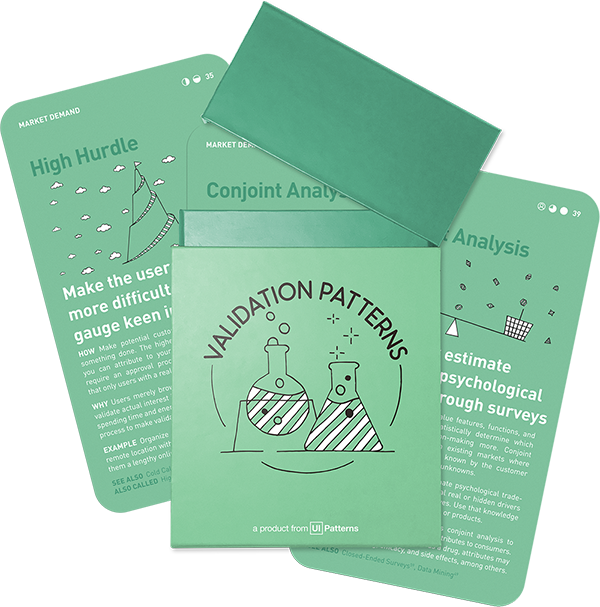Evidence strength
Relevant metrics: Views, Click through rate (CTR), Cost per click
Validates: Desirability
How: Create ads that take viewers to a page soliciting email sign-ups and possibly pre-orders. Experiment with ad text, keyword, text, and audience variations to understand which value proposition and audience match has the highest interest and yields the highest return.
Why: With a relative low effort you can conduct targeted and measurable tests on the wording of your value proposition and audience segments quickly without having an existing audience or product. Run test ads to determine what wording and benefits respond better with users before implementing and experimenting with more expensive landing pages.
This experiment is part of the Validation Patterns printed card deck
A collection of 60 product experiments that will validate your idea in a matter of days, not months. They are regularly used by product builders at companies like Google, Facebook, Dropbox, and Amazon.
Get your deck!Before the experiment
The first thing to do when planning any kind of test or experiment, is to figure out what you want to test. To make critical assumptions explicit, fill out an experiment sheet as you prepare your test. We created a sample sheet for you to get started. Download the Experiment Sheet.
Testing Value Propositions with ads
Pay-Per-Click (PPC) advertisements are particularly suitable for testing value propositions due to their ability to isolate value, force succinctness, and present direct competition. This method involves creating and testing unique PPC ads for each compelling reason identified in your value proposition. The performance of these ads can then be integrated into the design of landing pages for further testing.
A Value Proposition is the answer to why your ideal prospect should choose you over competitors. It’s not a high-level vision statement or a feature description but a concise, clear, and compelling reason to choose your product. In the fast-paced online environment, where web visitors have short attention spans, especially on mobile, the clarity and brevity of your Value Proposition become even more crucial.
PPC ads offer a unique testing ground for Value Propositions in an environment where succinct messaging is paramount. Their format aligns perfectly with the design of most landing pages, which typically consist of a headline, a subtitle, and a call to action. This synergy is vital for capturing the fleeting attention of web visitors.
Benefits include:
- Isolation of Value. PPC ads allow for the focus on Value Propositions without distractions, a critical factor given the limited attention span of online visitors.
- Enforced Succinctness. The character limits of PPC ads compel marketers to distill their message, aligning with the Nielsen Norman Group’s findings that web visitors make quick judgments.
- Direct Competition. By placing your Value Proposition in direct comparison with competitors, PPC ads provide immediate feedback on its effectiveness.
Platforms for Value Proposition Testing
There are a number of different platforms / network sthat can be used to test value propositions. The list below are the most commonly used platforms for testing:
- Google AdWords. Use targeted keywords to reach audiences interested in your solution. Measure the click-through rate of each ad variation to determine the most appealing aspects of your offer.
- Facebook & Instagram Ads (Meta). Segment your audience based on interest to test different value propositions. This method is particularly effective for products that might not attract organic search traffic but appeal to casual web browsers or specific demographics.
- Paid Email List Promotion. Utilize email ads on targeted industry lists to quickly gauge which aspects of your product resonate most with your audience.
Always create multiple variations
The great thing about digital advertisement platforms is, that they all come with A/B testing built in. The auction feature will allow you to test multiple variaitons up against each other in a short time, cheaply, and up against a rather large (and possibly segmented) audience.
What metrics to watch
When evaluating results, there are several metrics to take note of:
- Clicks-through-rate (CTR). Variations with a higher CTR convey a greater user interest.
- Cost Per Click (CPC). A low CPC clues that its easier to find interested users in this target segment. Possibly because the segment is large. Possibly because the ad competition within that keyword or segment is not big.
- Reach. While reach alone won’t reveal how engaged that audience is, it does tell you something about the size of the segment you targeted.
Identifying Your Target Customers Online
The journey begins with pinpointing where your target customers spend their time online. This involves asking some fundamental questions about their online behavior:
- What websites do they frequent?
- Which apps are part of their daily routine?
- Where do they hang out online?
Engage your team in this exploration and focus on 1-3 primary online locations for initial testing. A simple yet effective method is to have a team vote on where they believe the time and resources should be invested to reach the target customer online.
Push vs Pull
Your approach to reaching customers online can vary significantly.
Early adopters are the ideal initial test group for your product. These early adopters:
- Have a problem that your product can solve.
- Are aware of this problem.
- Have been actively seeking a solution.
Use your customer profile to assess whether your target customers are already aware of and seeking solutions to their problems.
The “Push” Approach. When your target customers are aware of the problem but not actively seeking a solution, a ‘push’ approach is appropriate. This involves display advertising targeting specific criteria like age, demographics, and location. The goal here is to build awareness and encourage potential customers to engage with your ad.
The “Pull” Approach. Conversely, for customers actively seeking solutions, the ‘pull’ approach is more effective. This strategy involves positioning your ads on search result pages, targeting users precisely when they are looking for solutions. These ads often appear at the top of search results, marked with an “Ad” superscript.
After launching your ads, closely monitor their performance. Use the insights gained to refine your approach, messaging, and targeting. Remember, the ultimate goal is to establish a problem-solution fit that resonates with your target audience.
After the experiment
To make sure you move forward, it is a good idea to systematically record your the insights you learned and what actions or decisions follow. We created a sample Learning Sheet, that will help you capture insights in the process of turning your product ideas successful. Download the Learning Sheet.
Examples
The 4-Hour Workweek
Author Tim Ferriss spent $200 on Google Ads to find his best-selling title. The 4-Hour Workweek has sold over 1.3M copies.
Source: HBR: How to Test Your Advertising Quickly, Cheaply, and Effectively
Buffer
Buffer, a social media management tool, has openly discussed their use of social media ads to test different value propositions. They ran various Facebook ad campaigns targeting different audience segments with different messages, closely monitoring the performance to understand which value propositions resonated most with their potential customers.
Source: Experimenting in Marketing: What I’ve Learned Running 25 A/B Tests on Ads for Buffer
Canva
Canva has used Google AdWords and Facebook Ads to test different messaging and value propositions. They have run multiple campaigns targeting different keywords and audience segments to understand what appeals most to their potential users, whether it’s the ease of use, the range of templates, or the collaborative features of their design platform.
Source: Case Study: How Canva use Google Ads to grow their business
Related plays
- HBR: How to Test Your Advertising Quickly, Cheaply, and Effectively by Howie Jacobson
- How To Validate Your Startup Idea by Nick Raushenbush

